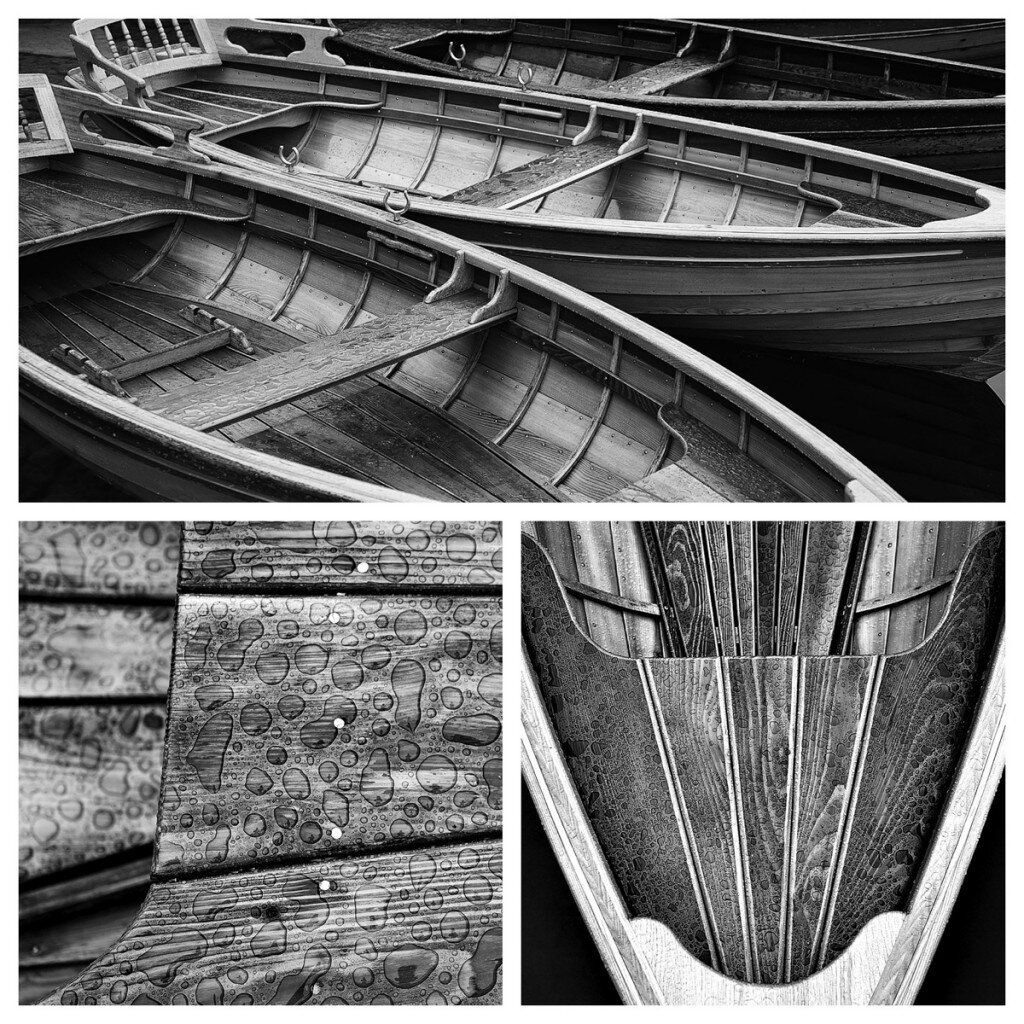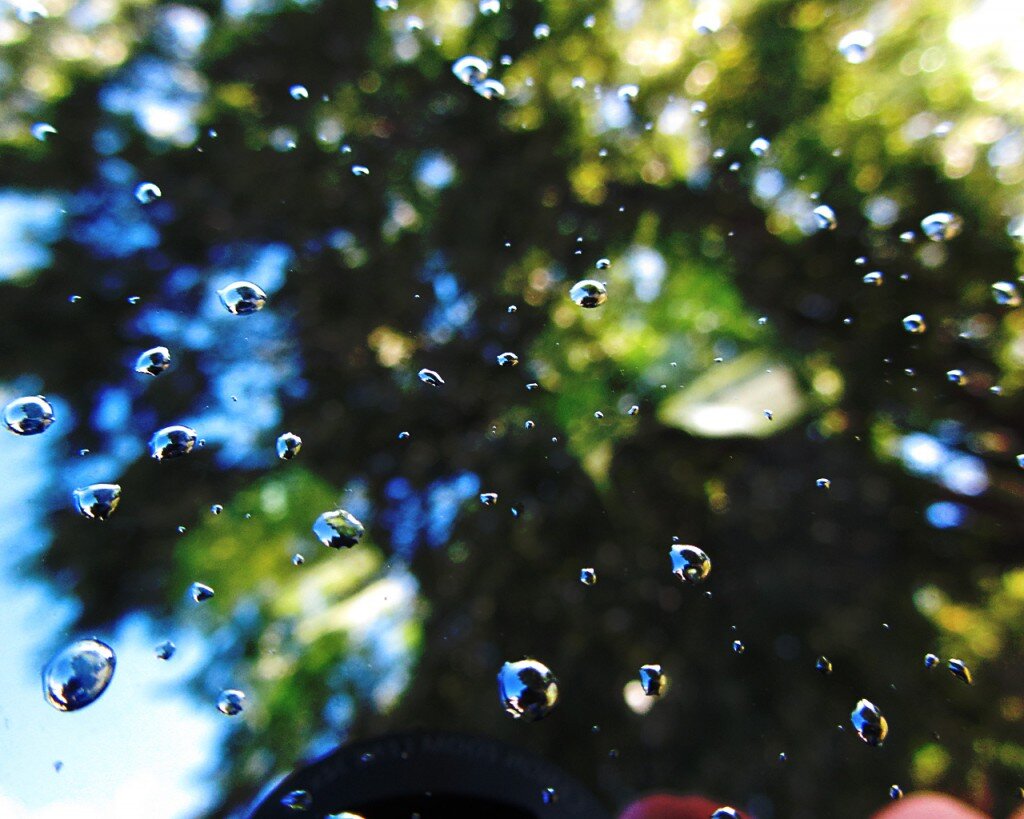 I've compared water drops to mercury before in this blog. But for those who have seen beads of mercury, you'd have to admit that these water drops, photographed from the inside of my pickup's front window, look more like silvery mercury than beads of water.A good photo? You'll make that judgement. A different view of reality? As a photographer, I try to offer that from time to time.Incidentally, this photo was taken with a Canon SX230 HS, a palm-sized point-and-shoot camera. I'm impressed with its ability to blur the background. And provide a little bokeh! Notice, incidentally, that the tree in the background is blurred but that each water drop acts as a lens and offers a somewhat focused view of the same tree.CanonSX230 HS 1/30s f/3.1 ISO640 5mm
I've compared water drops to mercury before in this blog. But for those who have seen beads of mercury, you'd have to admit that these water drops, photographed from the inside of my pickup's front window, look more like silvery mercury than beads of water.A good photo? You'll make that judgement. A different view of reality? As a photographer, I try to offer that from time to time.Incidentally, this photo was taken with a Canon SX230 HS, a palm-sized point-and-shoot camera. I'm impressed with its ability to blur the background. And provide a little bokeh! Notice, incidentally, that the tree in the background is blurred but that each water drop acts as a lens and offers a somewhat focused view of the same tree.CanonSX230 HS 1/30s f/3.1 ISO640 5mm
Photography
Breaking Ground
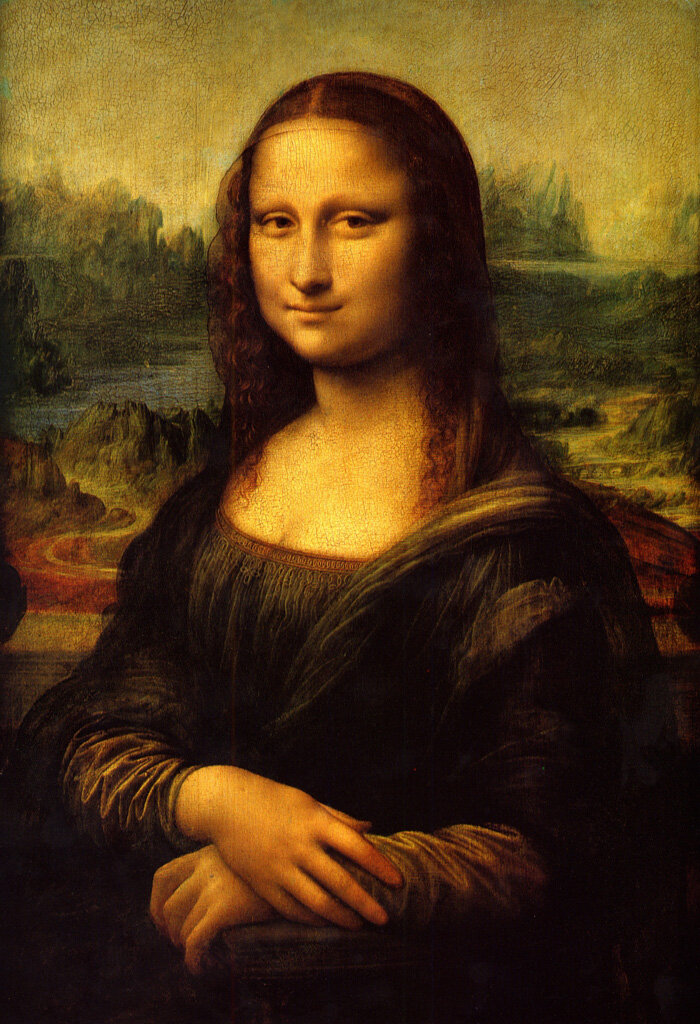 OK, so in a minor way I am breaking ground in this blog because I am A)publishing a painting and B)I am posting someone else's work. Why, you ask?The answer is that I am assigning a "Copy Da Vinci" portrait assignment to my studio photography students and I thought this might also teach you a little about how you might improve your portraits.What Da Vinci did in this painting that helped shape the future of portraiture lies in part in the way the subject is posed. Generally, portraits were full-body and in profile mode before Da Vinci. What Da Vinci did is that he angled Mona Lisa and chose to show us a view of her that focused on her face. Imagine that!Additionally, Mono Lisa is looking right at us and smiling that famous smile. The angle of her shoulders and the gentle position of her hands make Mona Lisa seem relaxed and real. Of course we try to get the same effect in modern portraits.Da Vinci did do one thing that I would tell my photography students not to do and it has to do with the way the hands are posed. These days the general rule that that the back of the hand should never face the camera. What that does is that it presents an element in the photo (due to its size and brightness) that that competes with the face. And a portrait generally is all about the face.Da Vinci gets away with this hand showing because of the neat, nearly triangular shape that defines Mona. And, of course, the face is what clearly dominates this painting.Do you want to take good photos? How about finding some great works of art and copying them. When you start to copy, you start to see techniques and compositional elements that you may not have otherwise seen.
OK, so in a minor way I am breaking ground in this blog because I am A)publishing a painting and B)I am posting someone else's work. Why, you ask?The answer is that I am assigning a "Copy Da Vinci" portrait assignment to my studio photography students and I thought this might also teach you a little about how you might improve your portraits.What Da Vinci did in this painting that helped shape the future of portraiture lies in part in the way the subject is posed. Generally, portraits were full-body and in profile mode before Da Vinci. What Da Vinci did is that he angled Mona Lisa and chose to show us a view of her that focused on her face. Imagine that!Additionally, Mono Lisa is looking right at us and smiling that famous smile. The angle of her shoulders and the gentle position of her hands make Mona Lisa seem relaxed and real. Of course we try to get the same effect in modern portraits.Da Vinci did do one thing that I would tell my photography students not to do and it has to do with the way the hands are posed. These days the general rule that that the back of the hand should never face the camera. What that does is that it presents an element in the photo (due to its size and brightness) that that competes with the face. And a portrait generally is all about the face.Da Vinci gets away with this hand showing because of the neat, nearly triangular shape that defines Mona. And, of course, the face is what clearly dominates this painting.Do you want to take good photos? How about finding some great works of art and copying them. When you start to copy, you start to see techniques and compositional elements that you may not have otherwise seen.
Emily
 This is a photo that I took a few years ago and used as a retouching demonstration for my Studio Photography class. It takes about 20 minutes per portrait to do the things I think need to be done, though I have Photoshop actions and filters that would do some of the same things in seconds. But while I think automation is generally good, the personal, discretionary touch of the photographer is usually better.A general retouching philosophy of mine is to avoid the temptation to "Photoshop" a photo too much. I told my students that I think that when the retouching is finished, the "real person" should remain. Skin texture, teeth color, beauty marks and scars are part of who we are. This photo of Emily is a fairly low resolution copy, but I think the an 8x10 print of this picture would reveal the "real" Emily.Canon 5dII 1/640s f/3.5 ISO400 135mm Canon 70-200 2.8 Lens
This is a photo that I took a few years ago and used as a retouching demonstration for my Studio Photography class. It takes about 20 minutes per portrait to do the things I think need to be done, though I have Photoshop actions and filters that would do some of the same things in seconds. But while I think automation is generally good, the personal, discretionary touch of the photographer is usually better.A general retouching philosophy of mine is to avoid the temptation to "Photoshop" a photo too much. I told my students that I think that when the retouching is finished, the "real person" should remain. Skin texture, teeth color, beauty marks and scars are part of who we are. This photo of Emily is a fairly low resolution copy, but I think the an 8x10 print of this picture would reveal the "real" Emily.Canon 5dII 1/640s f/3.5 ISO400 135mm Canon 70-200 2.8 Lens
Window Seat (iPhoneography)
 When I travel, I am as captivated by looking at the scenery as any other tourist. But if the situation allows it, I also like to take photos of people looking at the scenery. I guess I'm a bit of a voyeur in that sense.In this case, I was on a plane flying over the Grand Canyon on an amazingly clear day. I must have taken 50 photos with my iPhone before I noticed a young girl in the window seat ahead of me who was also captivated by what we were seeing 30,000 feet below us.And so I snapped this photo.
When I travel, I am as captivated by looking at the scenery as any other tourist. But if the situation allows it, I also like to take photos of people looking at the scenery. I guess I'm a bit of a voyeur in that sense.In this case, I was on a plane flying over the Grand Canyon on an amazingly clear day. I must have taken 50 photos with my iPhone before I noticed a young girl in the window seat ahead of me who was also captivated by what we were seeing 30,000 feet below us.And so I snapped this photo.
Shadow and Light
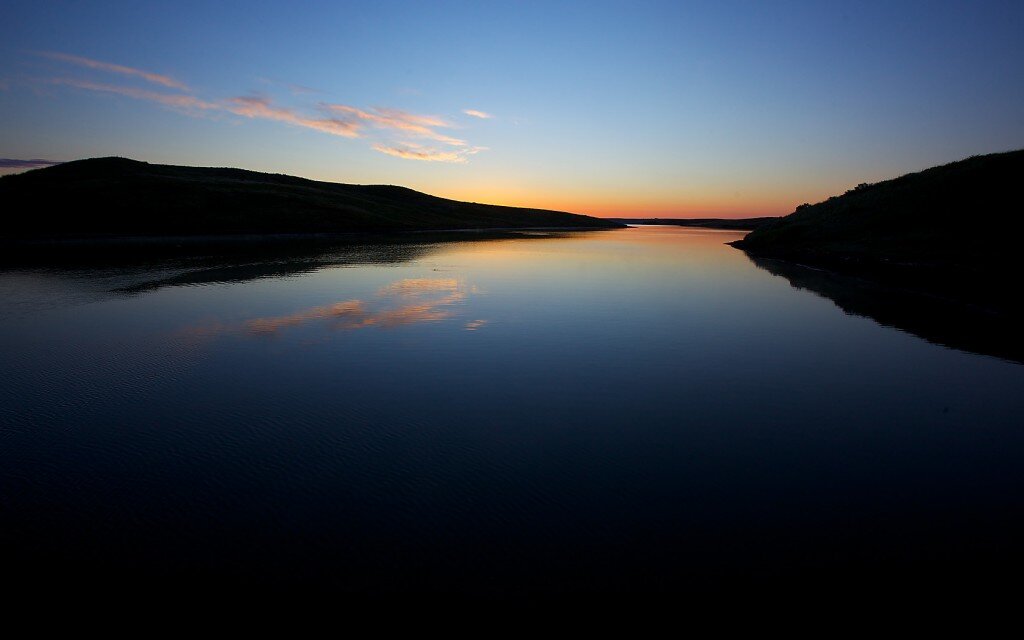 This is the fourth in a series of sunrise shots that were all taken within 30 minutes or so of each other. This photo was almost rejected (which is my way of throwing things away - kind of). The rejection would have been based on the fact that so little is well exposed on this frame. In fact I would say that as much as 1/2 of this photo is almost pure black. In my mind, that's not good.But, when I looked at this picture again, I like how the black parts of the photo frame the incipient sunrise. I think that how the water goes from black to deep blue to orange is especially interesting.So this one became a keeper.
This is the fourth in a series of sunrise shots that were all taken within 30 minutes or so of each other. This photo was almost rejected (which is my way of throwing things away - kind of). The rejection would have been based on the fact that so little is well exposed on this frame. In fact I would say that as much as 1/2 of this photo is almost pure black. In my mind, that's not good.But, when I looked at this picture again, I like how the black parts of the photo frame the incipient sunrise. I think that how the water goes from black to deep blue to orange is especially interesting.So this one became a keeper.
A Little Coffee
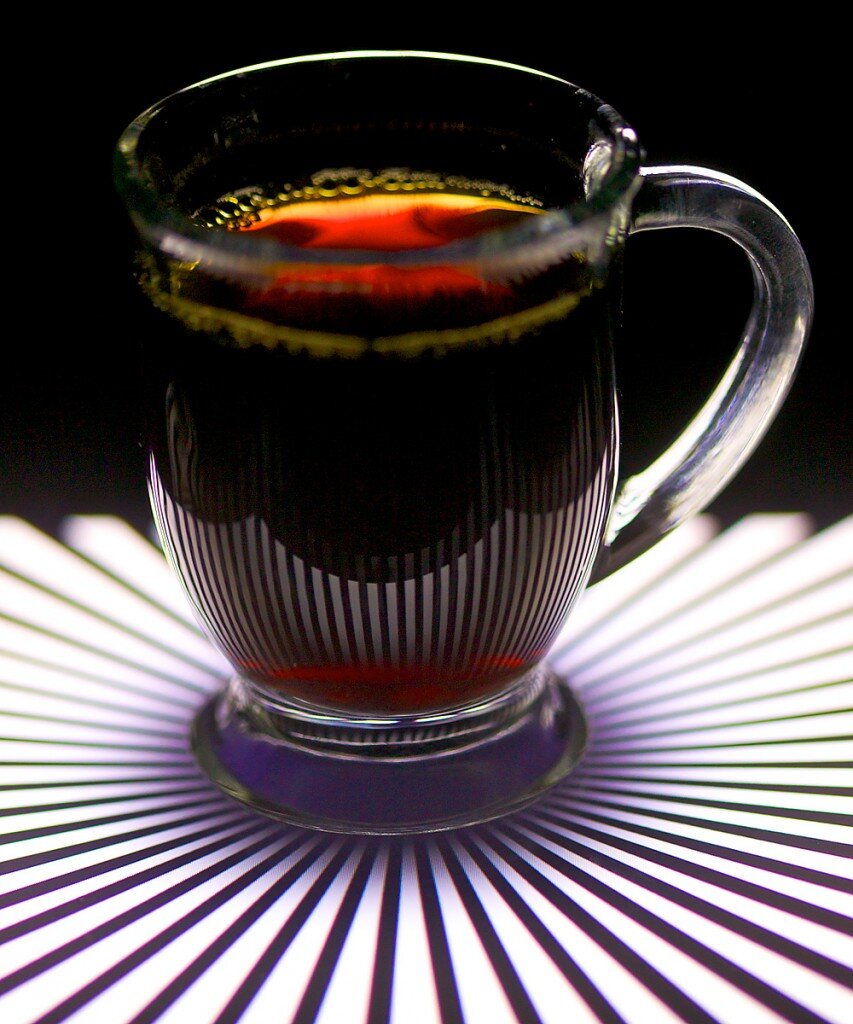 I took this quite a while ago using an iPad app I had read about called Photo Soft Box. You set any number of patterns on your iPad, find a dark room and an object that has interesting reflectivity and then take photos. I think it's pretty cool and a creative eye might find interesting things to do with this tool. Maybe sometime soon I'll give this app the time it deserves.
I took this quite a while ago using an iPad app I had read about called Photo Soft Box. You set any number of patterns on your iPad, find a dark room and an object that has interesting reflectivity and then take photos. I think it's pretty cool and a creative eye might find interesting things to do with this tool. Maybe sometime soon I'll give this app the time it deserves.
I Am No Claude Monet
 Nor was meant to be. (As TS Elliot might say.)*But just as Monet painted canvas after canvas of haystacks in different light, I seem to photograph clouds at sunrise fairly regularly. Redundant? Just as it was with Monet, for me it's not so much about the subject; it's about the light. And the place. . . .*No! I am not Prince Hamlet, nor was meant to be;Am an attendant lord, one that will doTo swell a progress, start a scene or twoAdvise the prince; no doubt, an easy tool,Deferential, glad to be of use,Politic, cautious, and meticulous;Full of high sentence, but a bit obtuse;At times, indeed, almost ridiculous—Almost, at times, the Fool.Love Song of J. Alfred Prufrock
Nor was meant to be. (As TS Elliot might say.)*But just as Monet painted canvas after canvas of haystacks in different light, I seem to photograph clouds at sunrise fairly regularly. Redundant? Just as it was with Monet, for me it's not so much about the subject; it's about the light. And the place. . . .*No! I am not Prince Hamlet, nor was meant to be;Am an attendant lord, one that will doTo swell a progress, start a scene or twoAdvise the prince; no doubt, an easy tool,Deferential, glad to be of use,Politic, cautious, and meticulous;Full of high sentence, but a bit obtuse;At times, indeed, almost ridiculous—Almost, at times, the Fool.Love Song of J. Alfred Prufrock
Still Seeing Green
 I took this photo this summer but when and where I don't remember. For me, this is unusual since taking a photo is rarely a casual or unconscious decision. I am generally pretty "focused" and very aware of the subject, the place and the act.This photo isn't anything to write home about, though there is something simple and elemental in drops of water on deep green leaves. And I do like taking photos of vegetation.
I took this photo this summer but when and where I don't remember. For me, this is unusual since taking a photo is rarely a casual or unconscious decision. I am generally pretty "focused" and very aware of the subject, the place and the act.This photo isn't anything to write home about, though there is something simple and elemental in drops of water on deep green leaves. And I do like taking photos of vegetation.
Sunset Cruise
 This photo was no accident, though I had no idea what I'd get when I starting taking photos of the water contrail behind my brother-in-law Scott's boat last night on Lake Okoboji in Iowa. I like the glow of the sunset still visible in the background but I especially like the creamy, dark blue look of the water rushing under the boat.Everything is blurred in this photo but I knew it would be since I was shooting with a pretty slow shutter speed and the boat was bouncing a bit.I'm not sure I would have tried taking this photo a year ago because sharpness and a solidly held camera are part of my photographic process. But lately I've decided that it's worth trying to take photos even if you meet with failure. Nothing ventured, nothing gained.Canon 5DII 1/6s f/4.0 ISO1250 24mm
This photo was no accident, though I had no idea what I'd get when I starting taking photos of the water contrail behind my brother-in-law Scott's boat last night on Lake Okoboji in Iowa. I like the glow of the sunset still visible in the background but I especially like the creamy, dark blue look of the water rushing under the boat.Everything is blurred in this photo but I knew it would be since I was shooting with a pretty slow shutter speed and the boat was bouncing a bit.I'm not sure I would have tried taking this photo a year ago because sharpness and a solidly held camera are part of my photographic process. But lately I've decided that it's worth trying to take photos even if you meet with failure. Nothing ventured, nothing gained.Canon 5DII 1/6s f/4.0 ISO1250 24mm
Another View
 I think this is the third year I have photographed this lilly and this morning when I took my tripod and camera out to the garden, my goal was to try to see this beautiful plant in a way I hadn't seen it before.I have said before that photographers have the power to define reality by framing the field of view in ways that the human eye and brain don't. Thus, we can show the "big picture" in a way that makes it interesting and we can move in close to show things that people wouldn't normally look at. This photo is an example of this, I think.When I took this photo, I stopped looking at the whole flower and instead looked at its parts, its lines and it colors. I also looked at how these parts related to the background. To me an important compositional element is the way the edges of the leaves define the green space in the middle.Is it a good photo? I'm not sure that I could ever answer that question about one of my pictures. All I know is that I feel I met my goal of giving people a new way to look at the stargazer lilly.
I think this is the third year I have photographed this lilly and this morning when I took my tripod and camera out to the garden, my goal was to try to see this beautiful plant in a way I hadn't seen it before.I have said before that photographers have the power to define reality by framing the field of view in ways that the human eye and brain don't. Thus, we can show the "big picture" in a way that makes it interesting and we can move in close to show things that people wouldn't normally look at. This photo is an example of this, I think.When I took this photo, I stopped looking at the whole flower and instead looked at its parts, its lines and it colors. I also looked at how these parts related to the background. To me an important compositional element is the way the edges of the leaves define the green space in the middle.Is it a good photo? I'm not sure that I could ever answer that question about one of my pictures. All I know is that I feel I met my goal of giving people a new way to look at the stargazer lilly.

